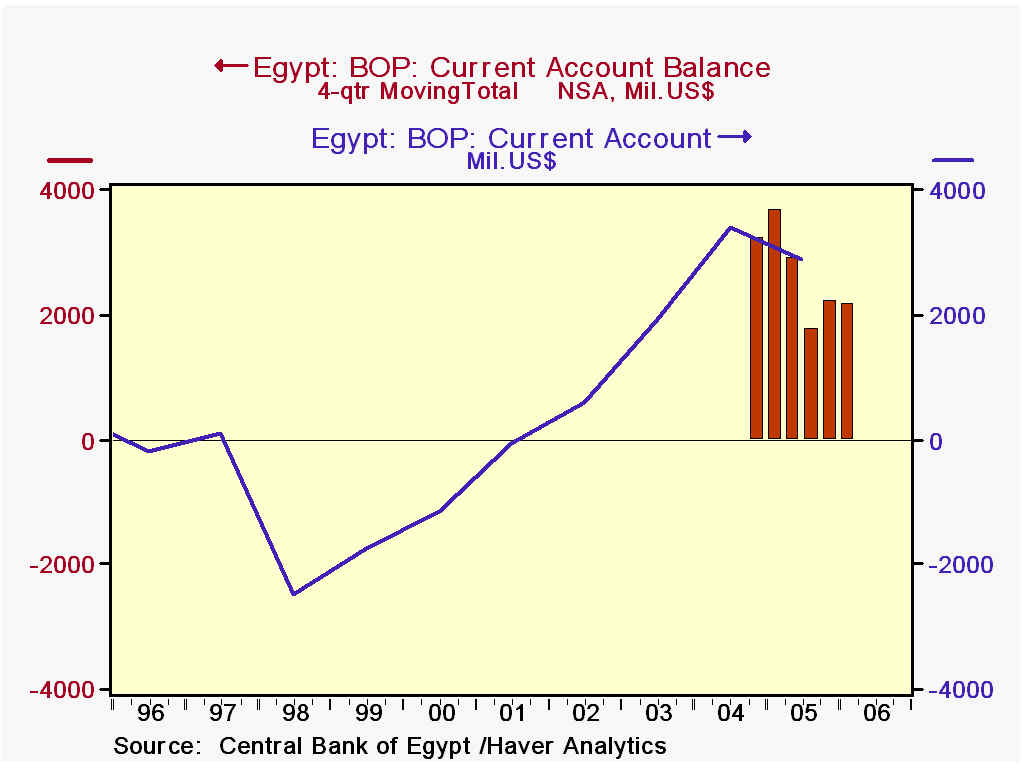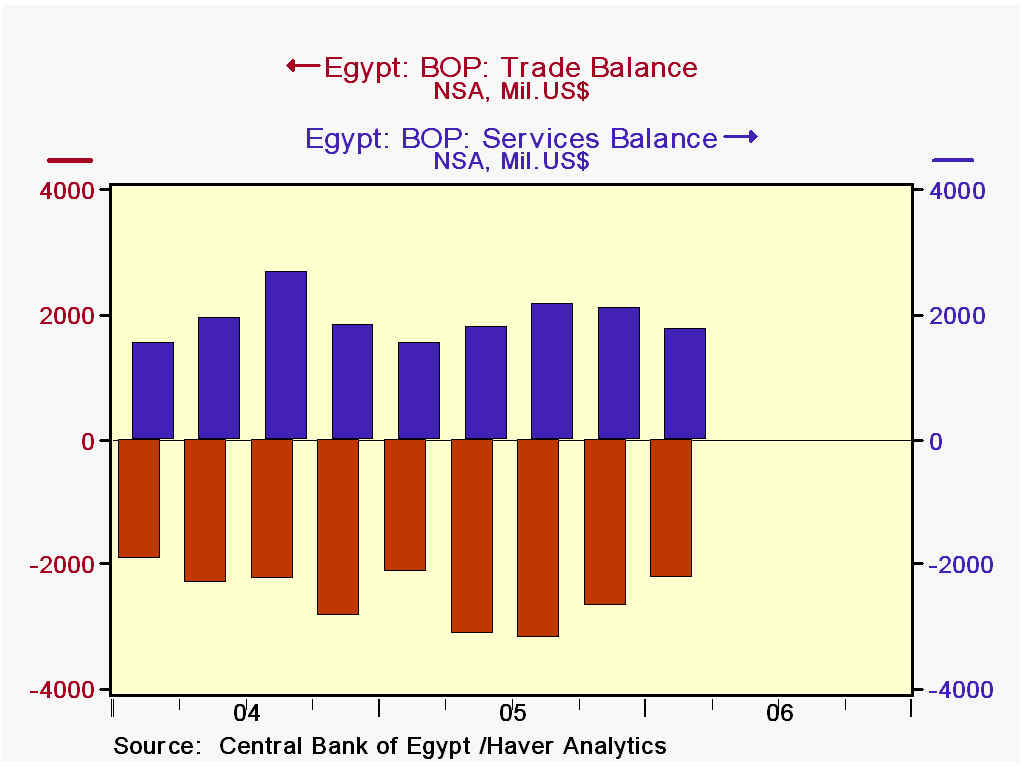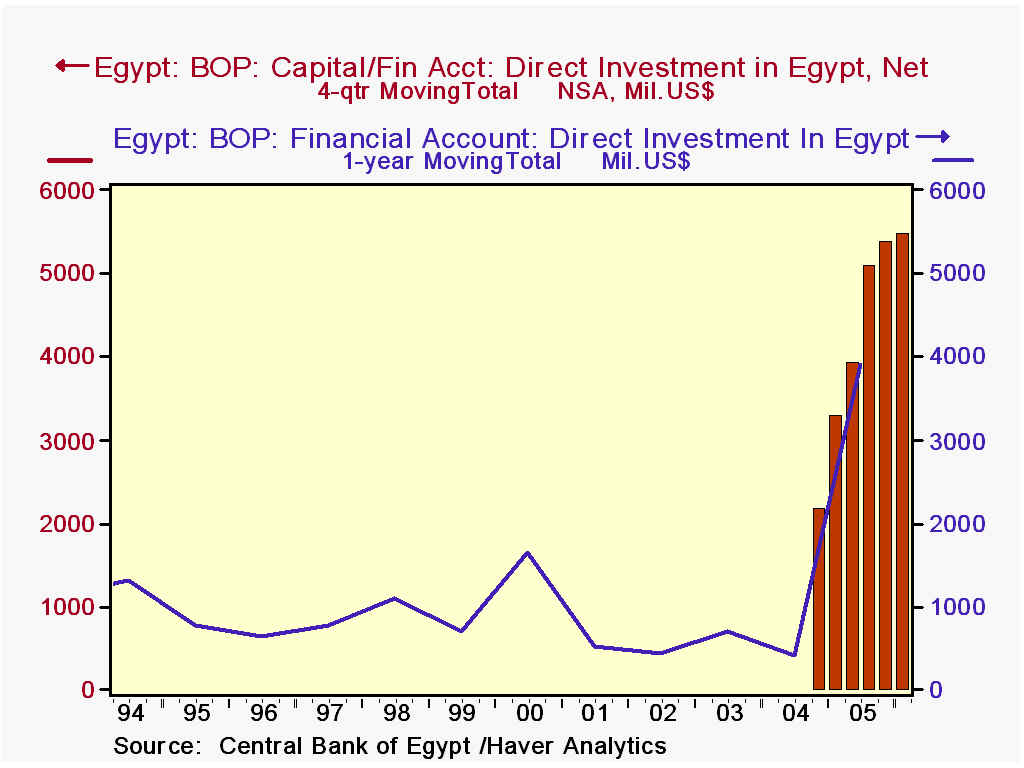 Global| Jul 20 2006
Global| Jul 20 2006Egypt's Current Account Surplus Boosted by Large Canal Tolls, Tourism and Petroleum; Direct Investment Gains
Summary
The Central Bank of Egypt today reported its balance of payments array for Q1 2006. The current account surplus increased to $934 million from $801 million in Q4 2005, although it was a bit smaller than Q1 2005 at $995 billion. For [...]

The Central Bank of Egypt today reported its balance of payments array for Q1 2006. The current account surplus increased to $934 million from $801 million in Q4 2005, although it was a bit smaller than Q1 2005 at $995 billion. For 2005 as a whole, Egypt had a current account surplus of $2.2 billion.
These numbers are small in absolute size. For instance, the balance on services in the US was $66.0 billion last year, nearly 9 times larger than Egypt's $7.6 billion. But some aspects of these Egyptian figures are quite fascinating and bear examination.
First, the current account itself shows a surplus. One frequently presumes that emerging market countries run perennial deficits and struggle constantly with debt and debt service issues. But presently, that situation is improving for Egypt. Its current account turned a surplus in its fiscal year 2002 (ended June 30, 2002) and has also achieved that every quarter since the quarterly data began in early 2004.
To be sure, the goods accounts are in deficit, which totaled $11.1 billion in calendar 2005 and continued with a $2.2 billion shortfall in Q1 2006. But Egypt has some oil and, as seen in the table below, is benefiting from the high prices with an increasing surplus in petroleum. This, of course, limits the overall deficit in goods.
The services accounts are important for Egypt. It collected nearly $3.5 billion last year in tolls from the Suez Canal, a strategic and lucrative asset for that nation. Egypt is able, too, to benefit from its ancient history as a tourist attraction, bringing a net of more than $5 billion to the country last year in travel accounts.
Lastly among the current accounts, the country receives substantial amounts of transfers. We in the US look at our transfer item as a drain, but sizable amounts of income go to Egypt, apparently from individuals working abroad. Total net transfers were $5.7 billion in 2005, with the portion from private sources amounting to almost exactly $5.0 billion.
On the capital and financial account side, the most outstanding item is the recent huge increase in direct investment in Egypt. As seen below, capital inflows for investment projects more than doubled in 2005 to $5.3 billion from $2.0 billion in 2004. The Q1 amount continues the 2005 pace. Information from news sources indicates that these funds cover a wide variety of activities, including manufacturing and the rapidly growing tourism sector. Recently announced projects include a major expansion of port facilities at Suez, so these flows are likely to remain sizable for a considerable period. At the same time, bank lending patterns indicate a persistent net outflow of capital from that sector.
All told, Egypt's balance of payments accounts are running a positive overall balance, as services, transfers and some capital accounts more than offset a deficit on goods trade. As a result, Egypt's reserves are increasing, in Q1 by $713 million, following a substantial $6.3 billion in 2005.
| Egypt: Mil. US$ | Q1 2006 | Q4 2005 | Q3 2005 | Q1 2005 | 2005 | 2004 |
|---|---|---|---|---|---|---|
| Current Account | 934 | 801 | 327 | 995 | 2,207 | 3,236 |
| Balance on Goods | -2,222 | -2,663 | -1,028 | -2,128 | -11,127 | -9,312 |
| Petroleum | 1,518 | 1,188 | 985 | 638 | 2,562 | 1,730 |
| Balance on Services | 1,780 | 2,074 | 2,170 | 1,530 | 7,586 | 7,982 |
| Suez Canal | 862 | 891 | 871 | 847 | 3,467 | 3,076 |
| Travel (Net) | 1,257 | 1,200 | 1,928 | 994 | 5,222 | 4,868 |
| Net Transfers | 1,376 | 1,390 | 1,355 | 1,593 | 5,748 | 4,567 |
| Net Direct Investment | 1,296 | 1,320 | 1,928 | 1,214 | 5,284 | 1,998 |
| Change in Reserves | 713 | 740 | 1,812 | 2,538 | 6,316 | 680 |
Carol Stone, CBE
AuthorMore in Author Profile »Carol Stone, CBE came to Haver Analytics in 2003 following more than 35 years as a financial market economist at major Wall Street financial institutions, most especially Merrill Lynch and Nomura Securities. She had broad experience in analysis and forecasting of flow-of-funds accounts, the federal budget and Federal Reserve operations. At Nomura Securities, among other duties, she developed various indicator forecasting tools and edited a daily global publication produced in London and New York for readers in Tokyo. At Haver Analytics, Carol was a member of the Research Department, aiding database managers with research and documentation efforts, as well as posting commentary on select economic reports. In addition, she conducted Ways-of-the-World, a blog on economic issues for an Episcopal-Church-affiliated website, The Geranium Farm. During her career, Carol served as an officer of the Money Marketeers and the Downtown Economists Club. She had a PhD from NYU's Stern School of Business. She lived in Brooklyn, New York, and had a weekend home on Long Island.





